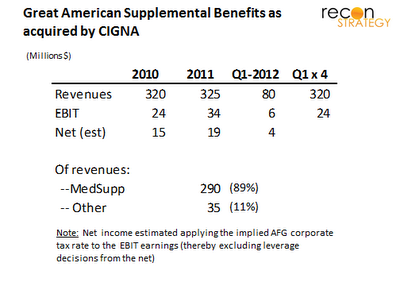Last week, CIGNA acquired the Great American Supplemental Benefits from American Financial Group (AFG) for $295M in cash. Per press releases, the key financials for the acquired business are:
A few observations on the acquired business:
- ~90% of the acquired revenue is driven by MedSupp. Public reports suggest 100K-125K MedSupp lives (250K lives total for the acquired business). Historically, AG’s MedSupp lives have been well distributed in the US with the exception of a sizeable position in Texas (the acquired business is Austin-based).
- The other 10% includes a variety of special health coverages including specified disease coverage for catastrophic conditions such as cancer, heart attack, transplant, stroke, ESRD as so forth. For example, the Cash Advantage product provides a cash benefit when a covered person is afflicted with one of the specified conditions to make up for lost income. There is also an individually rated “Affordable Health Benefits” product which would likely need to be radically redesigned under reform’s 2014 rules.
- Per press reports, Great American is ranked 16th in the market and was a second tier player even among multi-line insurances providing MedSupp. By comparison, CNO (under the brands Bankers Life, Washington National and Colonial Penn) earned revenues of $840M in MedSupp premiums in 2011 (nearly 3x the side of Great American). It is also worth noting that United now has 3.0M MedSupp lives (powered by its alliance with AARP).
- Most of these products are sold through independent agents, including a former captive agency that was sold by AFG in the fourth quarter of 2010 (per 10-K).
- Under AFG, the business does not seem to have been growing much, though earnings have been. The removal of the captive may be a partial driver of both the slow-down in growth and the increased profitability. That said, CNO’s MedSupp business has been flat since 2009 which may hint at a problem with MedSupp business model for multi-line insurers (United’s MedSupp business has been growing strongly over the same period).
Some thoughts on CIGNA strategy:
- The Great American MedSupp book complements CIGNA’s Medicare portfolio acquired through Healthspring (currently boasting 414K Medicare Advantage lives and 1.2M PDP lives). This will help with groups looking at multiple pathways in managing retirees, an nice cross-sell to CIGNA’s stand-alone PDP customers and make CIGNA a more attractive partner for brokers (by having a full complement of products).
- CIGNA probably has some work to do with the Great America legacy broker relationships (given that they were, until the end of 2010, “competing” with a captive agency). However, CIGNA seems – at least initially — interested in retaining them: in communications to the agents, it reassured that incentives would remain in place; CIGNA also promised a “full suite of products” for the agents to market for “years to come”. Certainly by bringing the Medicare Advantage and PDP offering, CIGNA should help its agents compete vs. the Bankers Trust brokers (which have been selling their MedSupp together with the Humana MA and PDP since 2009).
- Longer-term, the Great American acquisition builds out CIGNA’s specified diseases and other special coverages business (albeit nascent with $35M in revenue in 2011). These will fit well with consumer directed and account-based products and could play a great role on a private exchange or other defined contribution model. David Cordani did say in the most recent quarterly analyst call: “We do see some employers beginning to explore how they might move to the next generation of incentive alignment, which is a bit more of a defined contribution model.” Expect more acquisitions or alliances to build out a full defined contribution approach for commercial accounts (beyond retirement).

